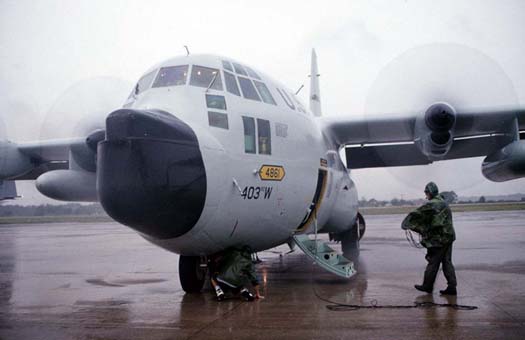WC-130 Hercules

Mission
The WC-130 Hercules is a high-wing, medium-range aircraft flown by the Air Force Reserve for weather reconnaissance missions.
Features
The WC-130 is capable of staying aloft nearly 18 hours during missions. It is equipped with two external 1,400 gallon (5,320 liter) fuel tanks, an internal 1,800 gallon (6,480 liter) fuel tank and uprated engines. An average weather reconnaissance mission might last 11 hours and cover almost 3,500 miles while the crew collects and reports weather data every minute.
Weather equipment aboard the aircraft include the Improved Weather Reconnaissance System (IWRS). This system consists of the Atmospheric Distributed Data System (ADDS) and Omega Dropsonde Windfinding System (ODWS).
The ADDS system provides a high-density, high accuracy horizontal atmospheric sensing capability. Sensors installed on the aircraft measure outside temperature, humidity, absolute altitude of the aircraft, pressure altitude, wind speed and direction once per second. This information, along with an evaluation of other meteorological conditions, turbulence, icing, radar returns and visibility, is encoded by the on-board meteorologist and transmitted by satellite to the National Hurricane Center, Miami, Fla..
The ODWS system measures the atmosphere vertically by using an expendable instrument which is dropped from the aircraft. The 16 inch-long cylinder is dropped every 400 miles while on a weather track and in the center or eye of a hurricane. A vertical atmospheric profile of pressure, temperature, humidity, barometric pressure, wind speed and direction is received from the dropsonde as it descends to the ocean surface. The dropsonde is slowed and stabilized by a small parachute. From this information, the dropsonde system operator analyzes and encodes data for satellite transmission to the National Hurricane Center.
The WC-130 is flown exclusively from Keesler Air Force Base, Miss., by Air Force Reserve organizations known as the Hurricane Hunters. The hurricane reconnaissance area includes the Atlantic Ocean, Caribbean Sea, Gulf of Mexico and central Pacific Ocean areas.
Background
The WC-130 Hercules is a modified version of the C-130 transport configured with computerized weather instrumentation for penetration of severe storms to obtain data on storm movements, dimensions and intensity. The WC-130B became operational in 1959, the E model in 1962, followed by the H model in 1964. Only the H model is currently in operation.
The WC-130 provides vital tropical cyclone forecasting information. It penetrates tropical cyclones and hurricanes at altitudes ranging from 500 to 10,000 feet (151.7 to 3033.3 meters) above the ocean surface depending upon the intensity of the storm. The aircraft's most important function is to collect high-density, high-accuracy weather data from within the storm's environment. This includes penetration of the center (eye) of the storm. This vital information is instantly relayed by satellite to the National Hurricane Center to aid in the accurate forecasting of hurricane movement and intensity.
General Characteristics
Primary
Function: Weather reconnaissance
Contractor: Lockheed
Aircraft Corp.
Power
Plant: Four Allison turboprop engines; T-56-A-15
Length: 99
feet, 4 inches (30.10 meters)
Height: 38
feet, 6 inches (11.67 meters)
Maximum
Takeoff Weight: 155,000 pounds (69,750 kilograms)
Wingspan: 132
feet, 6 inches (40.15 meters)
Range: 4,000
miles (3,478 nautical miles)
Ceiling: 33,000
feet (10,000 meters)
Endurance: Can
stay aloft 18 hours at 300-plus mph
Speed: 350-plus
mph (Mach 0.46; 304 knots per hour)
Crew: Six;
pilot, co-pilot, navigator, flight engineer, aerial reconnaissance weather
officer and dropsonde system operator
Date
Deployed: 1964
Unit
Cost: Approximately $13 million (1960 dollars)
Inventory: Active
force; 0; ANG, 0; Reserve, 10
